Corporate Finance: Facebook IPO Analysis & Capital Structure
VerifiedAdded on 2023/06/11
|21
|5759
|136
Case Study
AI Summary
This case study provides a comprehensive financial analysis of Facebook Corporation, evaluating its financial performance and capital structure before and after its Initial Public Offering (IPO). It examines the advantages and pitfalls of Facebook's IPO, including its motivations for going public and the challenges it faced. The report also delves into Facebook's capital-raising strategies, comparing stock market funding with debt funding, and analyzes the company's planned use of IPO proceeds. Furthermore, it discusses the dual-class share structure, the role of underwriters, and the impact of outlook revisions during the IPO. The analysis includes an assessment of Facebook's issue price using Discounted Cash Flow (DCF) and Comparable Companies Analysis (CCA) techniques, along with an evaluation of its stock performance and capital structure evolution since the IPO. The study concludes by summarizing the key findings and their implications for Facebook's financial strategy.
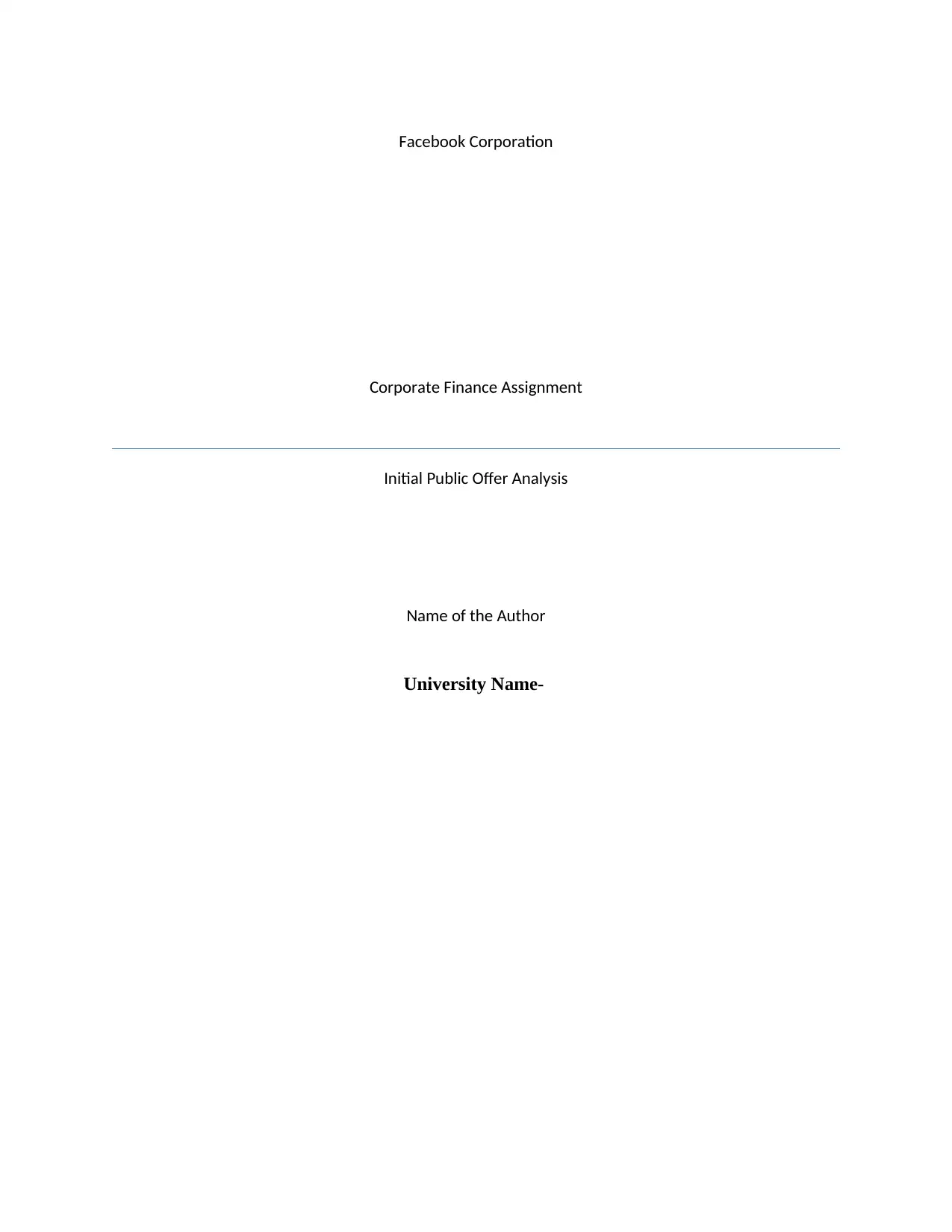
Facebook Corporation
Corporate Finance Assignment
Initial Public Offer Analysis
Name of the Author
University Name-
Corporate Finance Assignment
Initial Public Offer Analysis
Name of the Author
University Name-
Paraphrase This Document
Need a fresh take? Get an instant paraphrase of this document with our AI Paraphraser
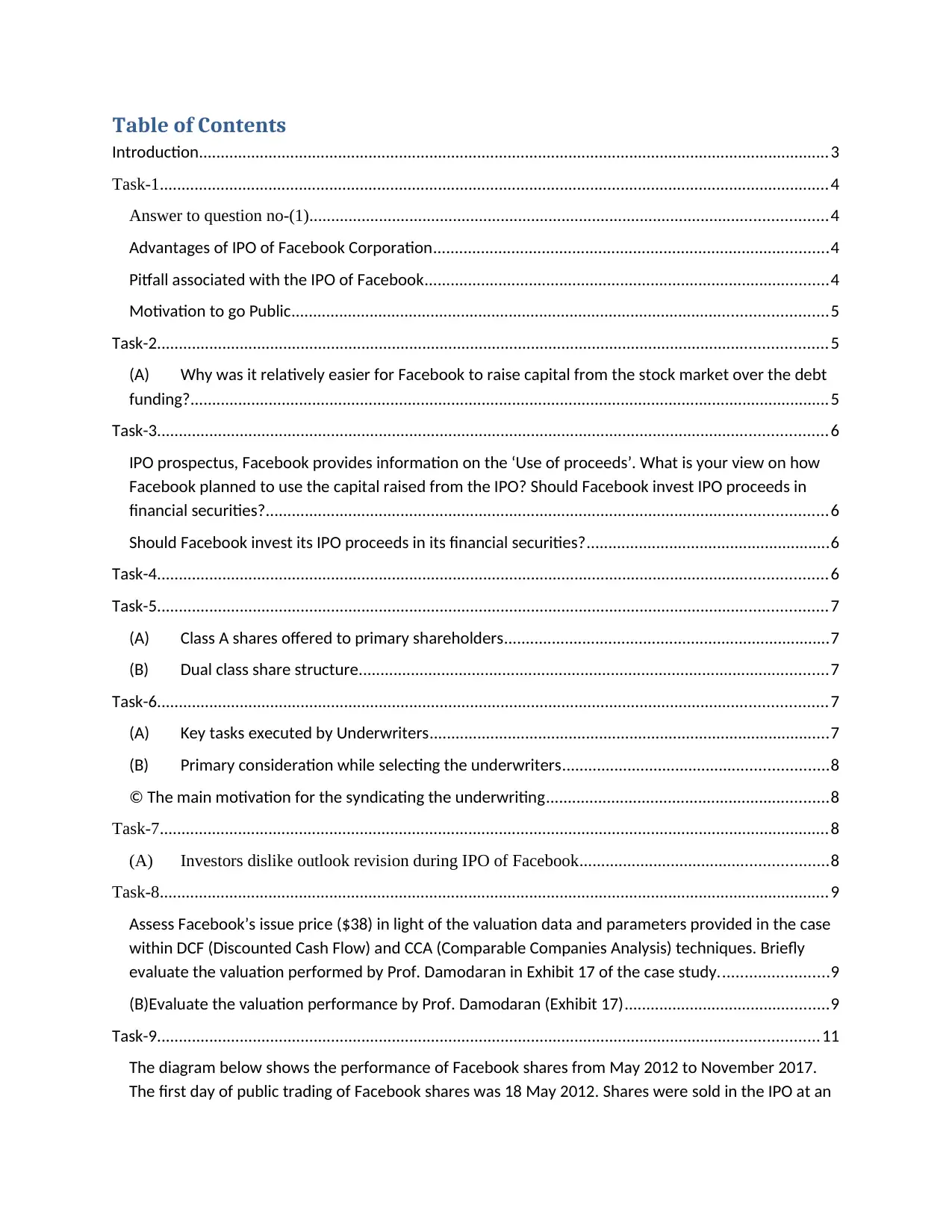
Table of Contents
Introduction.................................................................................................................................................3
Task-1..........................................................................................................................................................4
Answer to question no-(1).......................................................................................................................4
Advantages of IPO of Facebook Corporation...........................................................................................4
Pitfall associated with the IPO of Facebook.............................................................................................4
Motivation to go Public...........................................................................................................................5
Task-2..........................................................................................................................................................5
(A) Why was it relatively easier for Facebook to raise capital from the stock market over the debt
funding?...................................................................................................................................................5
Task-3..........................................................................................................................................................6
IPO prospectus, Facebook provides information on the ‘Use of proceeds’. What is your view on how
Facebook planned to use the capital raised from the IPO? Should Facebook invest IPO proceeds in
financial securities?.................................................................................................................................6
Should Facebook invest its IPO proceeds in its financial securities?........................................................6
Task-4..........................................................................................................................................................6
Task-5..........................................................................................................................................................7
(A) Class A shares offered to primary shareholders...........................................................................7
(B) Dual class share structure............................................................................................................7
Task-6..........................................................................................................................................................7
(A) Key tasks executed by Underwriters............................................................................................7
(B) Primary consideration while selecting the underwriters.............................................................8
© The main motivation for the syndicating the underwriting.................................................................8
Task-7..........................................................................................................................................................8
(A) Investors dislike outlook revision during IPO of Facebook.........................................................8
Task-8..........................................................................................................................................................9
Assess Facebook’s issue price ($38) in light of the valuation data and parameters provided in the case
within DCF (Discounted Cash Flow) and CCA (Comparable Companies Analysis) techniques. Briefly
evaluate the valuation performed by Prof. Damodaran in Exhibit 17 of the case study.........................9
(B)Evaluate the valuation performance by Prof. Damodaran (Exhibit 17)...............................................9
Task-9........................................................................................................................................................11
The diagram below shows the performance of Facebook shares from May 2012 to November 2017.
The first day of public trading of Facebook shares was 18 May 2012. Shares were sold in the IPO at an
Introduction.................................................................................................................................................3
Task-1..........................................................................................................................................................4
Answer to question no-(1).......................................................................................................................4
Advantages of IPO of Facebook Corporation...........................................................................................4
Pitfall associated with the IPO of Facebook.............................................................................................4
Motivation to go Public...........................................................................................................................5
Task-2..........................................................................................................................................................5
(A) Why was it relatively easier for Facebook to raise capital from the stock market over the debt
funding?...................................................................................................................................................5
Task-3..........................................................................................................................................................6
IPO prospectus, Facebook provides information on the ‘Use of proceeds’. What is your view on how
Facebook planned to use the capital raised from the IPO? Should Facebook invest IPO proceeds in
financial securities?.................................................................................................................................6
Should Facebook invest its IPO proceeds in its financial securities?........................................................6
Task-4..........................................................................................................................................................6
Task-5..........................................................................................................................................................7
(A) Class A shares offered to primary shareholders...........................................................................7
(B) Dual class share structure............................................................................................................7
Task-6..........................................................................................................................................................7
(A) Key tasks executed by Underwriters............................................................................................7
(B) Primary consideration while selecting the underwriters.............................................................8
© The main motivation for the syndicating the underwriting.................................................................8
Task-7..........................................................................................................................................................8
(A) Investors dislike outlook revision during IPO of Facebook.........................................................8
Task-8..........................................................................................................................................................9
Assess Facebook’s issue price ($38) in light of the valuation data and parameters provided in the case
within DCF (Discounted Cash Flow) and CCA (Comparable Companies Analysis) techniques. Briefly
evaluate the valuation performed by Prof. Damodaran in Exhibit 17 of the case study.........................9
(B)Evaluate the valuation performance by Prof. Damodaran (Exhibit 17)...............................................9
Task-9........................................................................................................................................................11
The diagram below shows the performance of Facebook shares from May 2012 to November 2017.
The first day of public trading of Facebook shares was 18 May 2012. Shares were sold in the IPO at an
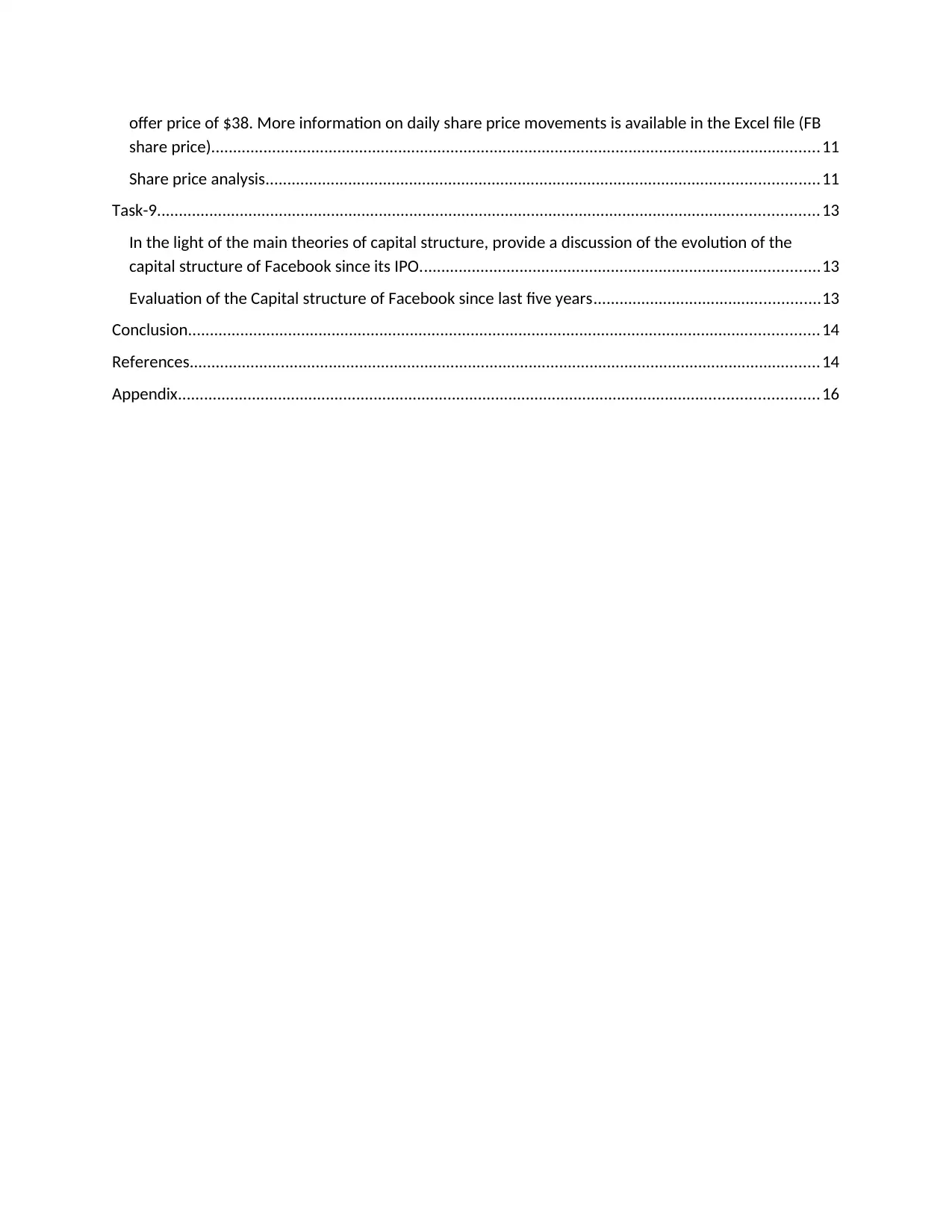
offer price of $38. More information on daily share price movements is available in the Excel file (FB
share price)............................................................................................................................................11
Share price analysis...............................................................................................................................11
Task-9........................................................................................................................................................13
In the light of the main theories of capital structure, provide a discussion of the evolution of the
capital structure of Facebook since its IPO............................................................................................13
Evaluation of the Capital structure of Facebook since last five years....................................................13
Conclusion.................................................................................................................................................14
References.................................................................................................................................................14
Appendix...................................................................................................................................................16
share price)............................................................................................................................................11
Share price analysis...............................................................................................................................11
Task-9........................................................................................................................................................13
In the light of the main theories of capital structure, provide a discussion of the evolution of the
capital structure of Facebook since its IPO............................................................................................13
Evaluation of the Capital structure of Facebook since last five years....................................................13
Conclusion.................................................................................................................................................14
References.................................................................................................................................................14
Appendix...................................................................................................................................................16
⊘ This is a preview!⊘
Do you want full access?
Subscribe today to unlock all pages.

Trusted by 1+ million students worldwide
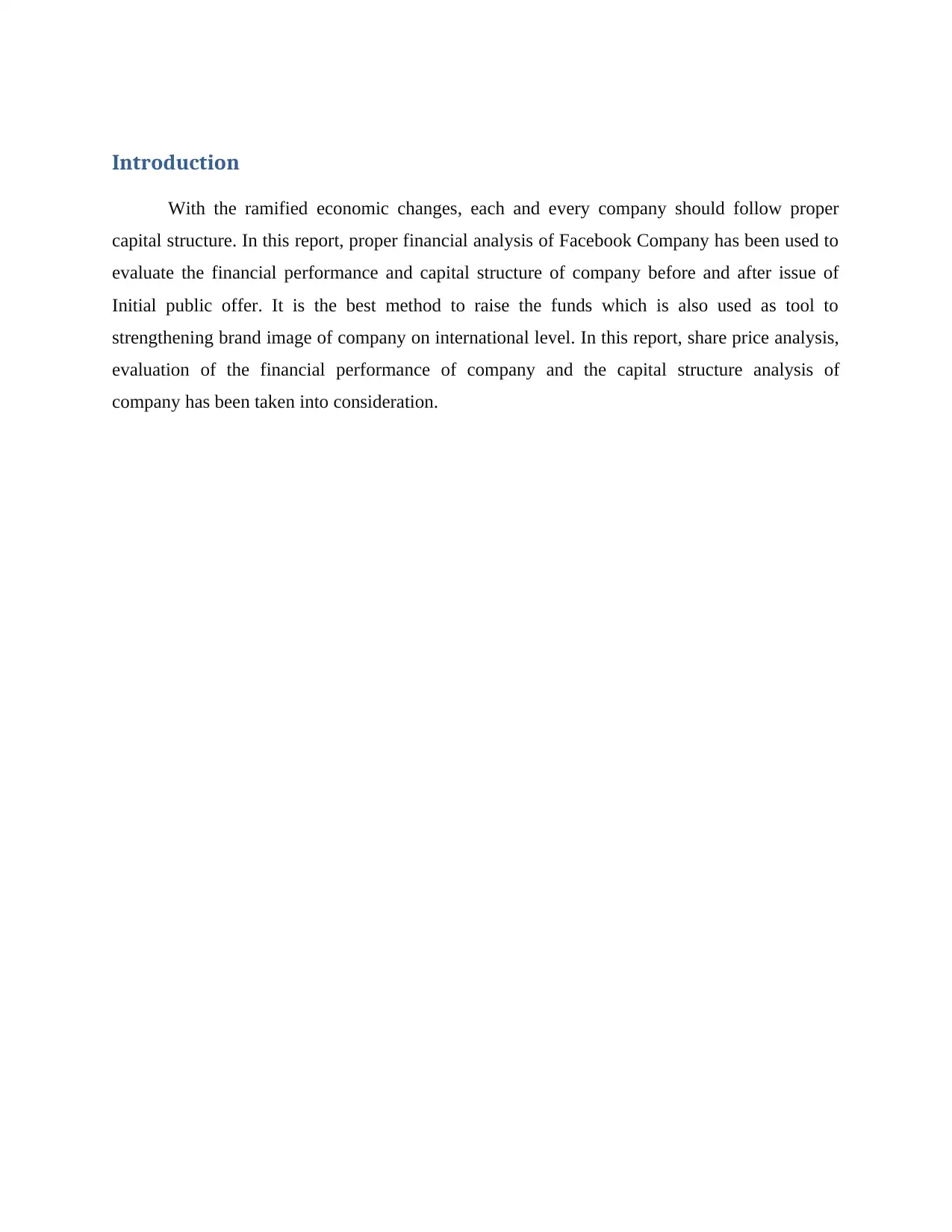
Introduction
With the ramified economic changes, each and every company should follow proper
capital structure. In this report, proper financial analysis of Facebook Company has been used to
evaluate the financial performance and capital structure of company before and after issue of
Initial public offer. It is the best method to raise the funds which is also used as tool to
strengthening brand image of company on international level. In this report, share price analysis,
evaluation of the financial performance of company and the capital structure analysis of
company has been taken into consideration.
With the ramified economic changes, each and every company should follow proper
capital structure. In this report, proper financial analysis of Facebook Company has been used to
evaluate the financial performance and capital structure of company before and after issue of
Initial public offer. It is the best method to raise the funds which is also used as tool to
strengthening brand image of company on international level. In this report, share price analysis,
evaluation of the financial performance of company and the capital structure analysis of
company has been taken into consideration.
Paraphrase This Document
Need a fresh take? Get an instant paraphrase of this document with our AI Paraphraser
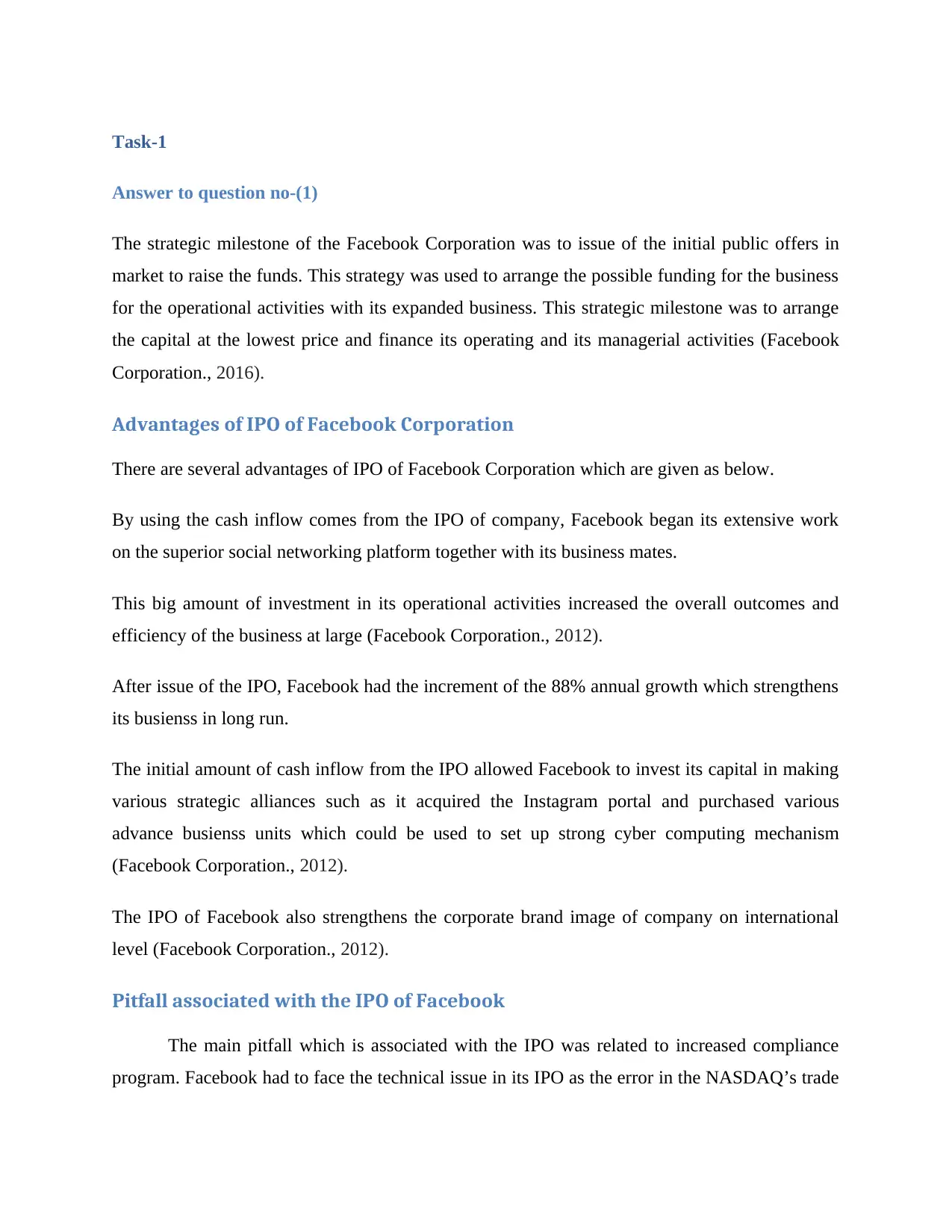
Task-1
Answer to question no-(1)
The strategic milestone of the Facebook Corporation was to issue of the initial public offers in
market to raise the funds. This strategy was used to arrange the possible funding for the business
for the operational activities with its expanded business. This strategic milestone was to arrange
the capital at the lowest price and finance its operating and its managerial activities (Facebook
Corporation., 2016).
Advantages of IPO of Facebook Corporation
There are several advantages of IPO of Facebook Corporation which are given as below.
By using the cash inflow comes from the IPO of company, Facebook began its extensive work
on the superior social networking platform together with its business mates.
This big amount of investment in its operational activities increased the overall outcomes and
efficiency of the business at large (Facebook Corporation., 2012).
After issue of the IPO, Facebook had the increment of the 88% annual growth which strengthens
its busienss in long run.
The initial amount of cash inflow from the IPO allowed Facebook to invest its capital in making
various strategic alliances such as it acquired the Instagram portal and purchased various
advance busienss units which could be used to set up strong cyber computing mechanism
(Facebook Corporation., 2012).
The IPO of Facebook also strengthens the corporate brand image of company on international
level (Facebook Corporation., 2012).
Pitfall associated with the IPO of Facebook
The main pitfall which is associated with the IPO was related to increased compliance
program. Facebook had to face the technical issue in its IPO as the error in the NASDAQ’s trade
Answer to question no-(1)
The strategic milestone of the Facebook Corporation was to issue of the initial public offers in
market to raise the funds. This strategy was used to arrange the possible funding for the business
for the operational activities with its expanded business. This strategic milestone was to arrange
the capital at the lowest price and finance its operating and its managerial activities (Facebook
Corporation., 2016).
Advantages of IPO of Facebook Corporation
There are several advantages of IPO of Facebook Corporation which are given as below.
By using the cash inflow comes from the IPO of company, Facebook began its extensive work
on the superior social networking platform together with its business mates.
This big amount of investment in its operational activities increased the overall outcomes and
efficiency of the business at large (Facebook Corporation., 2012).
After issue of the IPO, Facebook had the increment of the 88% annual growth which strengthens
its busienss in long run.
The initial amount of cash inflow from the IPO allowed Facebook to invest its capital in making
various strategic alliances such as it acquired the Instagram portal and purchased various
advance busienss units which could be used to set up strong cyber computing mechanism
(Facebook Corporation., 2012).
The IPO of Facebook also strengthens the corporate brand image of company on international
level (Facebook Corporation., 2012).
Pitfall associated with the IPO of Facebook
The main pitfall which is associated with the IPO was related to increased compliance
program. Facebook had to face the technical issue in its IPO as the error in the NASDAQ’s trade
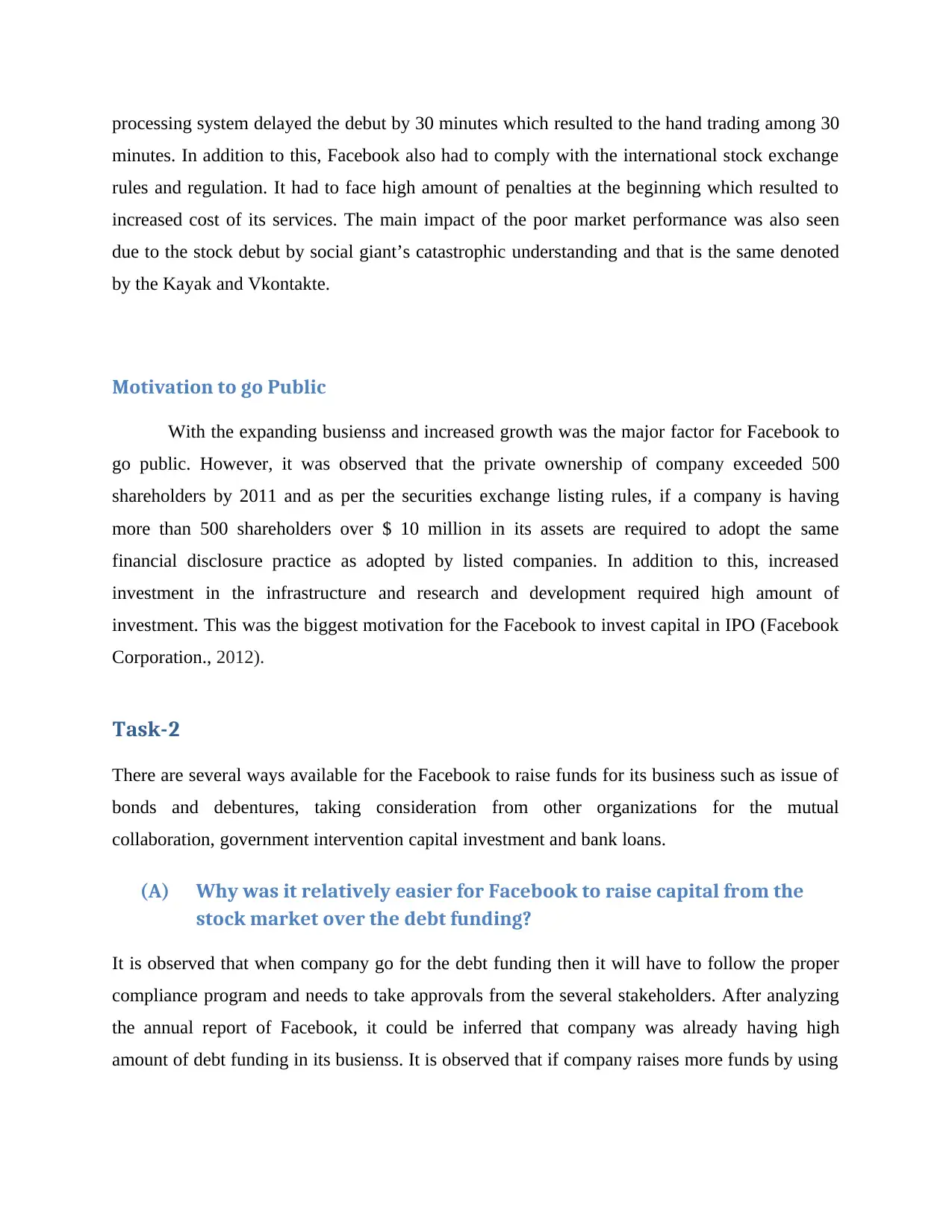
processing system delayed the debut by 30 minutes which resulted to the hand trading among 30
minutes. In addition to this, Facebook also had to comply with the international stock exchange
rules and regulation. It had to face high amount of penalties at the beginning which resulted to
increased cost of its services. The main impact of the poor market performance was also seen
due to the stock debut by social giant’s catastrophic understanding and that is the same denoted
by the Kayak and Vkontakte.
Motivation to go Public
With the expanding busienss and increased growth was the major factor for Facebook to
go public. However, it was observed that the private ownership of company exceeded 500
shareholders by 2011 and as per the securities exchange listing rules, if a company is having
more than 500 shareholders over $ 10 million in its assets are required to adopt the same
financial disclosure practice as adopted by listed companies. In addition to this, increased
investment in the infrastructure and research and development required high amount of
investment. This was the biggest motivation for the Facebook to invest capital in IPO (Facebook
Corporation., 2012).
Task-2
There are several ways available for the Facebook to raise funds for its business such as issue of
bonds and debentures, taking consideration from other organizations for the mutual
collaboration, government intervention capital investment and bank loans.
(A) Why was it relatively easier for Facebook to raise capital from the
stock market over the debt funding?
It is observed that when company go for the debt funding then it will have to follow the proper
compliance program and needs to take approvals from the several stakeholders. After analyzing
the annual report of Facebook, it could be inferred that company was already having high
amount of debt funding in its busienss. It is observed that if company raises more funds by using
minutes. In addition to this, Facebook also had to comply with the international stock exchange
rules and regulation. It had to face high amount of penalties at the beginning which resulted to
increased cost of its services. The main impact of the poor market performance was also seen
due to the stock debut by social giant’s catastrophic understanding and that is the same denoted
by the Kayak and Vkontakte.
Motivation to go Public
With the expanding busienss and increased growth was the major factor for Facebook to
go public. However, it was observed that the private ownership of company exceeded 500
shareholders by 2011 and as per the securities exchange listing rules, if a company is having
more than 500 shareholders over $ 10 million in its assets are required to adopt the same
financial disclosure practice as adopted by listed companies. In addition to this, increased
investment in the infrastructure and research and development required high amount of
investment. This was the biggest motivation for the Facebook to invest capital in IPO (Facebook
Corporation., 2012).
Task-2
There are several ways available for the Facebook to raise funds for its business such as issue of
bonds and debentures, taking consideration from other organizations for the mutual
collaboration, government intervention capital investment and bank loans.
(A) Why was it relatively easier for Facebook to raise capital from the
stock market over the debt funding?
It is observed that when company go for the debt funding then it will have to follow the proper
compliance program and needs to take approvals from the several stakeholders. After analyzing
the annual report of Facebook, it could be inferred that company was already having high
amount of debt funding in its busienss. It is observed that if company raises more funds by using
⊘ This is a preview!⊘
Do you want full access?
Subscribe today to unlock all pages.

Trusted by 1+ million students worldwide
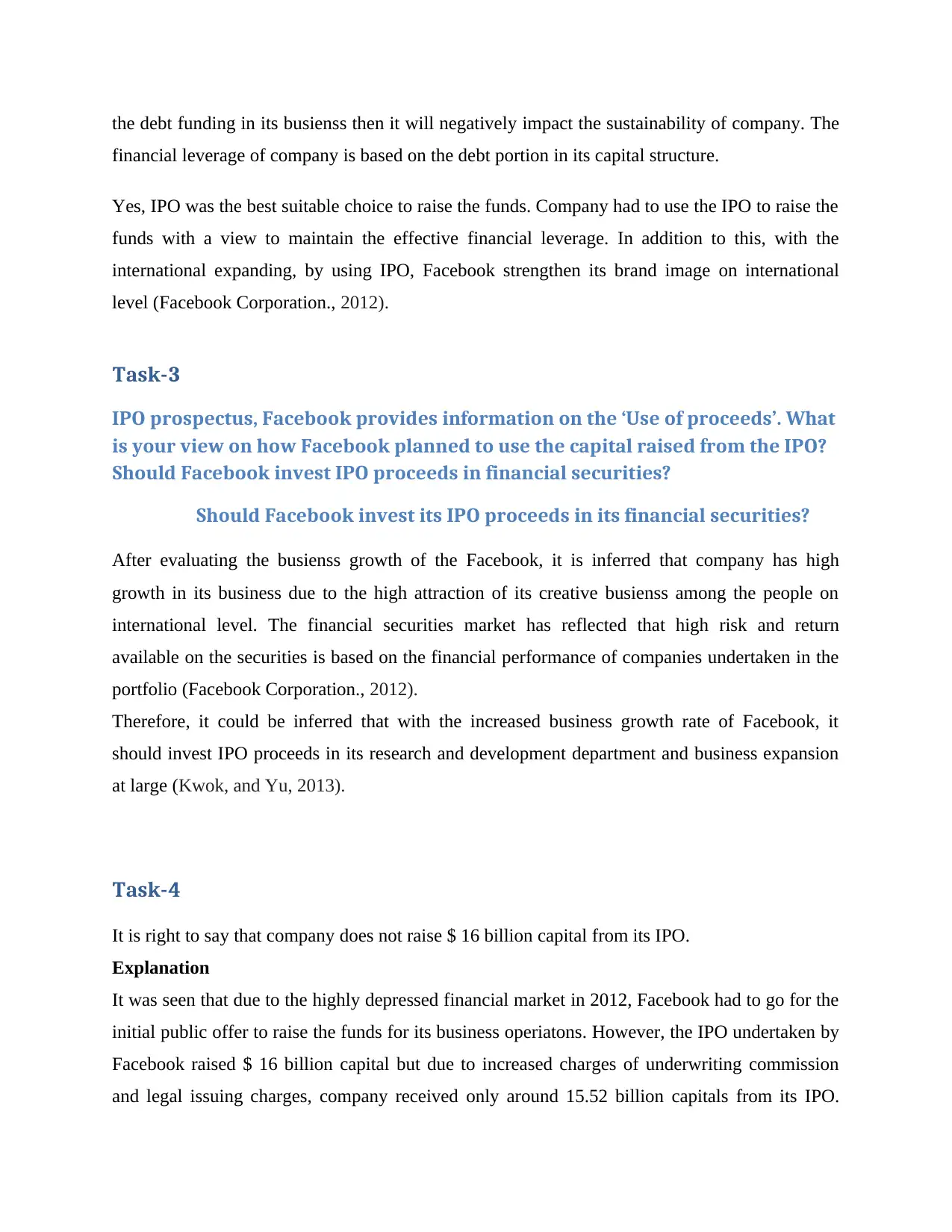
the debt funding in its busienss then it will negatively impact the sustainability of company. The
financial leverage of company is based on the debt portion in its capital structure.
Yes, IPO was the best suitable choice to raise the funds. Company had to use the IPO to raise the
funds with a view to maintain the effective financial leverage. In addition to this, with the
international expanding, by using IPO, Facebook strengthen its brand image on international
level (Facebook Corporation., 2012).
Task-3
IPO prospectus, Facebook provides information on the ‘Use of proceeds’. What
is your view on how Facebook planned to use the capital raised from the IPO?
Should Facebook invest IPO proceeds in financial securities?
Should Facebook invest its IPO proceeds in its financial securities?
After evaluating the busienss growth of the Facebook, it is inferred that company has high
growth in its business due to the high attraction of its creative busienss among the people on
international level. The financial securities market has reflected that high risk and return
available on the securities is based on the financial performance of companies undertaken in the
portfolio (Facebook Corporation., 2012).
Therefore, it could be inferred that with the increased business growth rate of Facebook, it
should invest IPO proceeds in its research and development department and business expansion
at large (Kwok, and Yu, 2013).
Task-4
It is right to say that company does not raise $ 16 billion capital from its IPO.
Explanation
It was seen that due to the highly depressed financial market in 2012, Facebook had to go for the
initial public offer to raise the funds for its business operiatons. However, the IPO undertaken by
Facebook raised $ 16 billion capital but due to increased charges of underwriting commission
and legal issuing charges, company received only around 15.52 billion capitals from its IPO.
financial leverage of company is based on the debt portion in its capital structure.
Yes, IPO was the best suitable choice to raise the funds. Company had to use the IPO to raise the
funds with a view to maintain the effective financial leverage. In addition to this, with the
international expanding, by using IPO, Facebook strengthen its brand image on international
level (Facebook Corporation., 2012).
Task-3
IPO prospectus, Facebook provides information on the ‘Use of proceeds’. What
is your view on how Facebook planned to use the capital raised from the IPO?
Should Facebook invest IPO proceeds in financial securities?
Should Facebook invest its IPO proceeds in its financial securities?
After evaluating the busienss growth of the Facebook, it is inferred that company has high
growth in its business due to the high attraction of its creative busienss among the people on
international level. The financial securities market has reflected that high risk and return
available on the securities is based on the financial performance of companies undertaken in the
portfolio (Facebook Corporation., 2012).
Therefore, it could be inferred that with the increased business growth rate of Facebook, it
should invest IPO proceeds in its research and development department and business expansion
at large (Kwok, and Yu, 2013).
Task-4
It is right to say that company does not raise $ 16 billion capital from its IPO.
Explanation
It was seen that due to the highly depressed financial market in 2012, Facebook had to go for the
initial public offer to raise the funds for its business operiatons. However, the IPO undertaken by
Facebook raised $ 16 billion capital but due to increased charges of underwriting commission
and legal issuing charges, company received only around 15.52 billion capitals from its IPO.
Paraphrase This Document
Need a fresh take? Get an instant paraphrase of this document with our AI Paraphraser
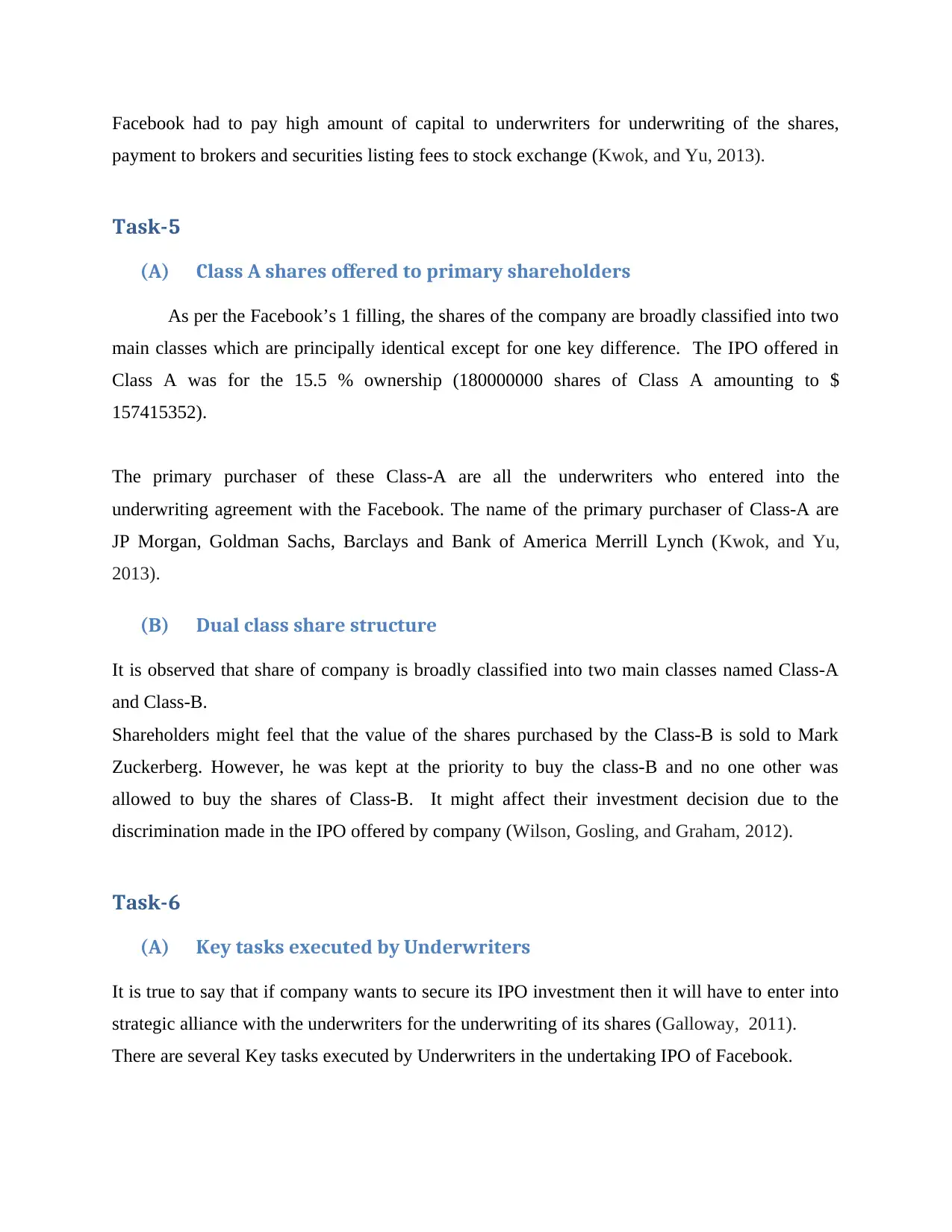
Facebook had to pay high amount of capital to underwriters for underwriting of the shares,
payment to brokers and securities listing fees to stock exchange (Kwok, and Yu, 2013).
Task-5
(A) Class A shares offered to primary shareholders
As per the Facebook’s 1 filling, the shares of the company are broadly classified into two
main classes which are principally identical except for one key difference. The IPO offered in
Class A was for the 15.5 % ownership (180000000 shares of Class A amounting to $
157415352).
The primary purchaser of these Class-A are all the underwriters who entered into the
underwriting agreement with the Facebook. The name of the primary purchaser of Class-A are
JP Morgan, Goldman Sachs, Barclays and Bank of America Merrill Lynch (Kwok, and Yu,
2013).
(B) Dual class share structure
It is observed that share of company is broadly classified into two main classes named Class-A
and Class-B.
Shareholders might feel that the value of the shares purchased by the Class-B is sold to Mark
Zuckerberg. However, he was kept at the priority to buy the class-B and no one other was
allowed to buy the shares of Class-B. It might affect their investment decision due to the
discrimination made in the IPO offered by company (Wilson, Gosling, and Graham, 2012).
Task-6
(A) Key tasks executed by Underwriters
It is true to say that if company wants to secure its IPO investment then it will have to enter into
strategic alliance with the underwriters for the underwriting of its shares (Galloway, 2011).
There are several Key tasks executed by Underwriters in the undertaking IPO of Facebook.
payment to brokers and securities listing fees to stock exchange (Kwok, and Yu, 2013).
Task-5
(A) Class A shares offered to primary shareholders
As per the Facebook’s 1 filling, the shares of the company are broadly classified into two
main classes which are principally identical except for one key difference. The IPO offered in
Class A was for the 15.5 % ownership (180000000 shares of Class A amounting to $
157415352).
The primary purchaser of these Class-A are all the underwriters who entered into the
underwriting agreement with the Facebook. The name of the primary purchaser of Class-A are
JP Morgan, Goldman Sachs, Barclays and Bank of America Merrill Lynch (Kwok, and Yu,
2013).
(B) Dual class share structure
It is observed that share of company is broadly classified into two main classes named Class-A
and Class-B.
Shareholders might feel that the value of the shares purchased by the Class-B is sold to Mark
Zuckerberg. However, he was kept at the priority to buy the class-B and no one other was
allowed to buy the shares of Class-B. It might affect their investment decision due to the
discrimination made in the IPO offered by company (Wilson, Gosling, and Graham, 2012).
Task-6
(A) Key tasks executed by Underwriters
It is true to say that if company wants to secure its IPO investment then it will have to enter into
strategic alliance with the underwriters for the underwriting of its shares (Galloway, 2011).
There are several Key tasks executed by Underwriters in the undertaking IPO of Facebook.
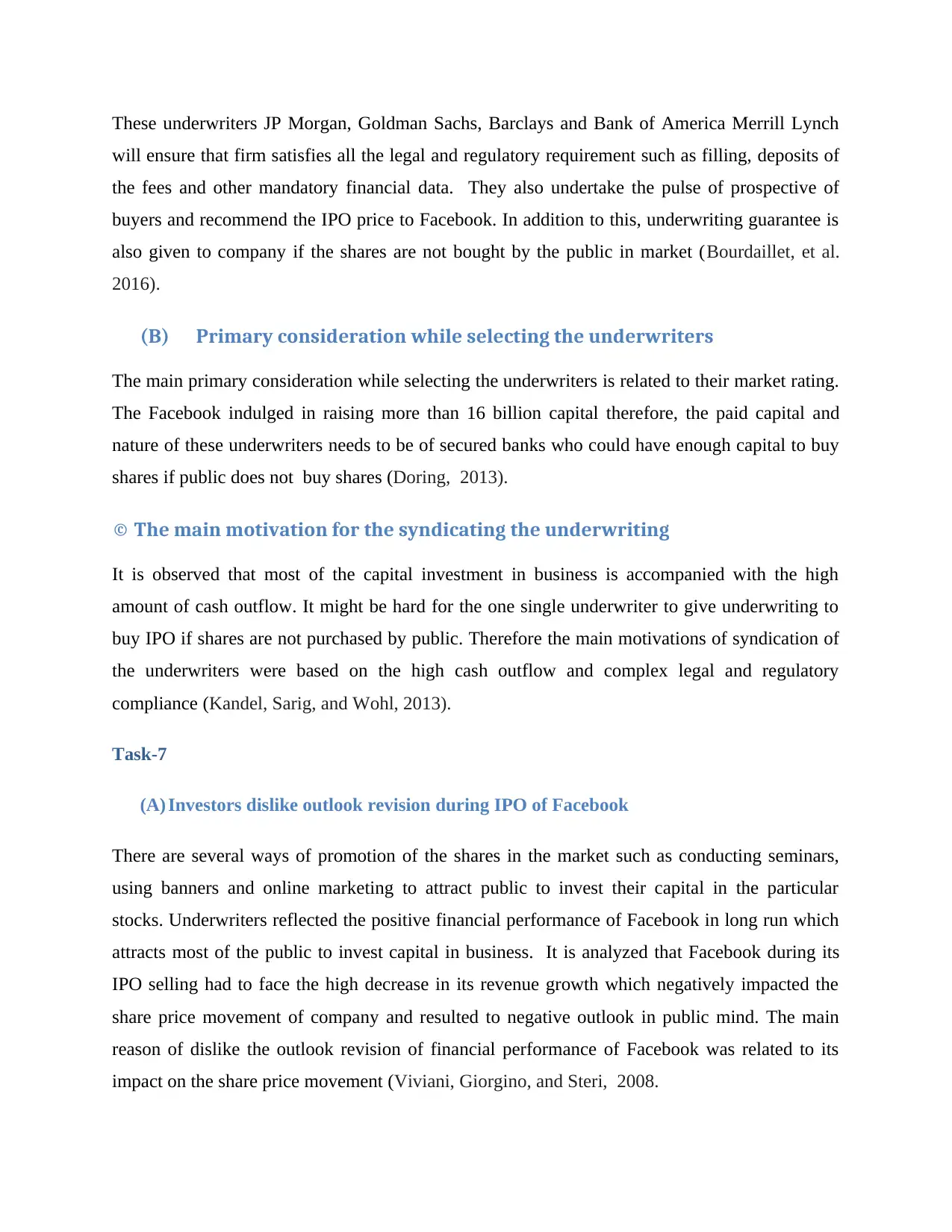
These underwriters JP Morgan, Goldman Sachs, Barclays and Bank of America Merrill Lynch
will ensure that firm satisfies all the legal and regulatory requirement such as filling, deposits of
the fees and other mandatory financial data. They also undertake the pulse of prospective of
buyers and recommend the IPO price to Facebook. In addition to this, underwriting guarantee is
also given to company if the shares are not bought by the public in market (Bourdaillet, et al.
2016).
(B) Primary consideration while selecting the underwriters
The main primary consideration while selecting the underwriters is related to their market rating.
The Facebook indulged in raising more than 16 billion capital therefore, the paid capital and
nature of these underwriters needs to be of secured banks who could have enough capital to buy
shares if public does not buy shares (Doring, 2013).
© The main motivation for the syndicating the underwriting
It is observed that most of the capital investment in business is accompanied with the high
amount of cash outflow. It might be hard for the one single underwriter to give underwriting to
buy IPO if shares are not purchased by public. Therefore the main motivations of syndication of
the underwriters were based on the high cash outflow and complex legal and regulatory
compliance (Kandel, Sarig, and Wohl, 2013).
Task-7
(A) Investors dislike outlook revision during IPO of Facebook
There are several ways of promotion of the shares in the market such as conducting seminars,
using banners and online marketing to attract public to invest their capital in the particular
stocks. Underwriters reflected the positive financial performance of Facebook in long run which
attracts most of the public to invest capital in business. It is analyzed that Facebook during its
IPO selling had to face the high decrease in its revenue growth which negatively impacted the
share price movement of company and resulted to negative outlook in public mind. The main
reason of dislike the outlook revision of financial performance of Facebook was related to its
impact on the share price movement (Viviani, Giorgino, and Steri, 2008.
will ensure that firm satisfies all the legal and regulatory requirement such as filling, deposits of
the fees and other mandatory financial data. They also undertake the pulse of prospective of
buyers and recommend the IPO price to Facebook. In addition to this, underwriting guarantee is
also given to company if the shares are not bought by the public in market (Bourdaillet, et al.
2016).
(B) Primary consideration while selecting the underwriters
The main primary consideration while selecting the underwriters is related to their market rating.
The Facebook indulged in raising more than 16 billion capital therefore, the paid capital and
nature of these underwriters needs to be of secured banks who could have enough capital to buy
shares if public does not buy shares (Doring, 2013).
© The main motivation for the syndicating the underwriting
It is observed that most of the capital investment in business is accompanied with the high
amount of cash outflow. It might be hard for the one single underwriter to give underwriting to
buy IPO if shares are not purchased by public. Therefore the main motivations of syndication of
the underwriters were based on the high cash outflow and complex legal and regulatory
compliance (Kandel, Sarig, and Wohl, 2013).
Task-7
(A) Investors dislike outlook revision during IPO of Facebook
There are several ways of promotion of the shares in the market such as conducting seminars,
using banners and online marketing to attract public to invest their capital in the particular
stocks. Underwriters reflected the positive financial performance of Facebook in long run which
attracts most of the public to invest capital in business. It is analyzed that Facebook during its
IPO selling had to face the high decrease in its revenue growth which negatively impacted the
share price movement of company and resulted to negative outlook in public mind. The main
reason of dislike the outlook revision of financial performance of Facebook was related to its
impact on the share price movement (Viviani, Giorgino, and Steri, 2008.
⊘ This is a preview!⊘
Do you want full access?
Subscribe today to unlock all pages.

Trusted by 1+ million students worldwide
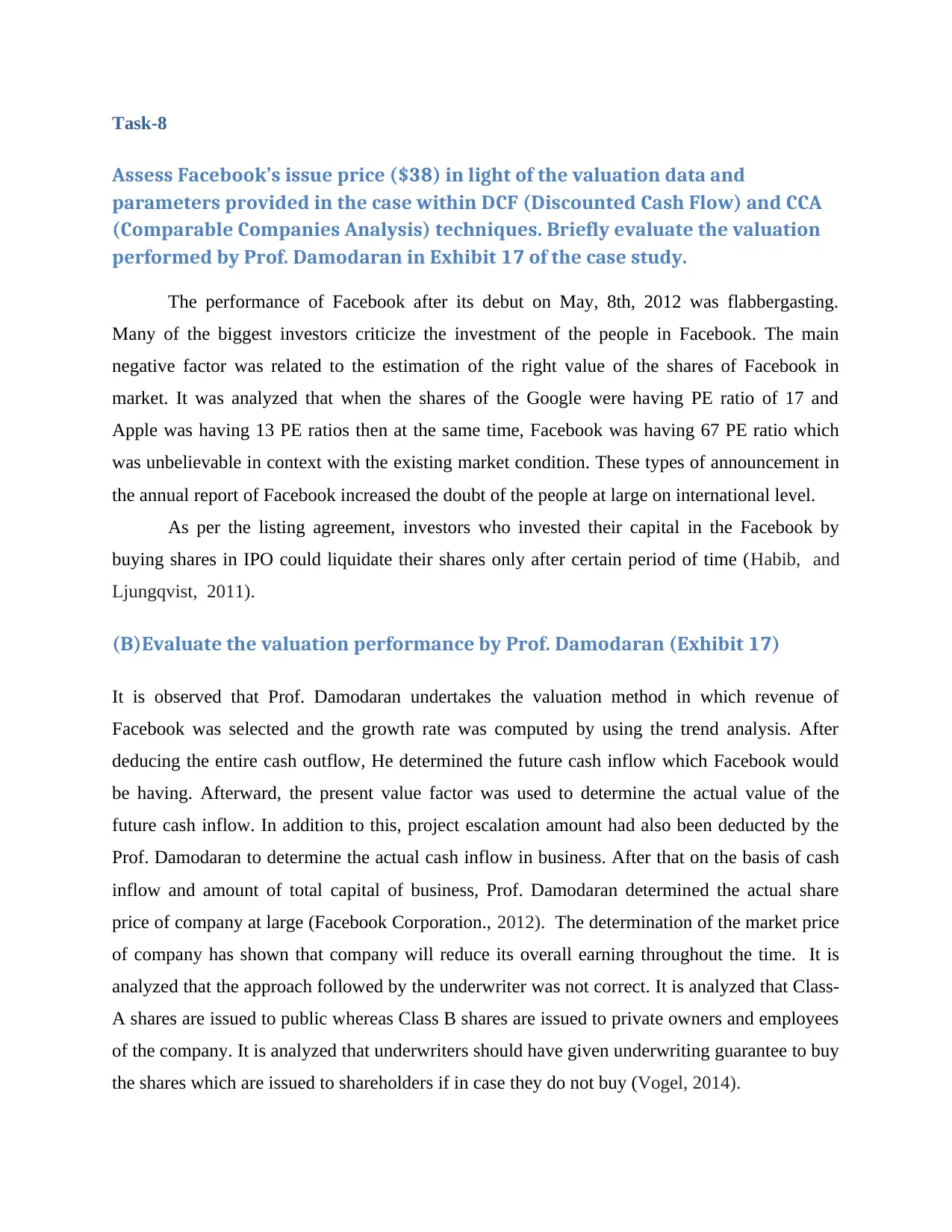
Task-8
Assess Facebook’s issue price ($38) in light of the valuation data and
parameters provided in the case within DCF (Discounted Cash Flow) and CCA
(Comparable Companies Analysis) techniques. Briefly evaluate the valuation
performed by Prof. Damodaran in Exhibit 17 of the case study.
The performance of Facebook after its debut on May, 8th, 2012 was flabbergasting.
Many of the biggest investors criticize the investment of the people in Facebook. The main
negative factor was related to the estimation of the right value of the shares of Facebook in
market. It was analyzed that when the shares of the Google were having PE ratio of 17 and
Apple was having 13 PE ratios then at the same time, Facebook was having 67 PE ratio which
was unbelievable in context with the existing market condition. These types of announcement in
the annual report of Facebook increased the doubt of the people at large on international level.
As per the listing agreement, investors who invested their capital in the Facebook by
buying shares in IPO could liquidate their shares only after certain period of time (Habib, and
Ljungqvist, 2011).
(B)Evaluate the valuation performance by Prof. Damodaran (Exhibit 17)
It is observed that Prof. Damodaran undertakes the valuation method in which revenue of
Facebook was selected and the growth rate was computed by using the trend analysis. After
deducing the entire cash outflow, He determined the future cash inflow which Facebook would
be having. Afterward, the present value factor was used to determine the actual value of the
future cash inflow. In addition to this, project escalation amount had also been deducted by the
Prof. Damodaran to determine the actual cash inflow in business. After that on the basis of cash
inflow and amount of total capital of business, Prof. Damodaran determined the actual share
price of company at large (Facebook Corporation., 2012). The determination of the market price
of company has shown that company will reduce its overall earning throughout the time. It is
analyzed that the approach followed by the underwriter was not correct. It is analyzed that Class-
A shares are issued to public whereas Class B shares are issued to private owners and employees
of the company. It is analyzed that underwriters should have given underwriting guarantee to buy
the shares which are issued to shareholders if in case they do not buy (Vogel, 2014).
Assess Facebook’s issue price ($38) in light of the valuation data and
parameters provided in the case within DCF (Discounted Cash Flow) and CCA
(Comparable Companies Analysis) techniques. Briefly evaluate the valuation
performed by Prof. Damodaran in Exhibit 17 of the case study.
The performance of Facebook after its debut on May, 8th, 2012 was flabbergasting.
Many of the biggest investors criticize the investment of the people in Facebook. The main
negative factor was related to the estimation of the right value of the shares of Facebook in
market. It was analyzed that when the shares of the Google were having PE ratio of 17 and
Apple was having 13 PE ratios then at the same time, Facebook was having 67 PE ratio which
was unbelievable in context with the existing market condition. These types of announcement in
the annual report of Facebook increased the doubt of the people at large on international level.
As per the listing agreement, investors who invested their capital in the Facebook by
buying shares in IPO could liquidate their shares only after certain period of time (Habib, and
Ljungqvist, 2011).
(B)Evaluate the valuation performance by Prof. Damodaran (Exhibit 17)
It is observed that Prof. Damodaran undertakes the valuation method in which revenue of
Facebook was selected and the growth rate was computed by using the trend analysis. After
deducing the entire cash outflow, He determined the future cash inflow which Facebook would
be having. Afterward, the present value factor was used to determine the actual value of the
future cash inflow. In addition to this, project escalation amount had also been deducted by the
Prof. Damodaran to determine the actual cash inflow in business. After that on the basis of cash
inflow and amount of total capital of business, Prof. Damodaran determined the actual share
price of company at large (Facebook Corporation., 2012). The determination of the market price
of company has shown that company will reduce its overall earning throughout the time. It is
analyzed that the approach followed by the underwriter was not correct. It is analyzed that Class-
A shares are issued to public whereas Class B shares are issued to private owners and employees
of the company. It is analyzed that underwriters should have given underwriting guarantee to buy
the shares which are issued to shareholders if in case they do not buy (Vogel, 2014).
Paraphrase This Document
Need a fresh take? Get an instant paraphrase of this document with our AI Paraphraser
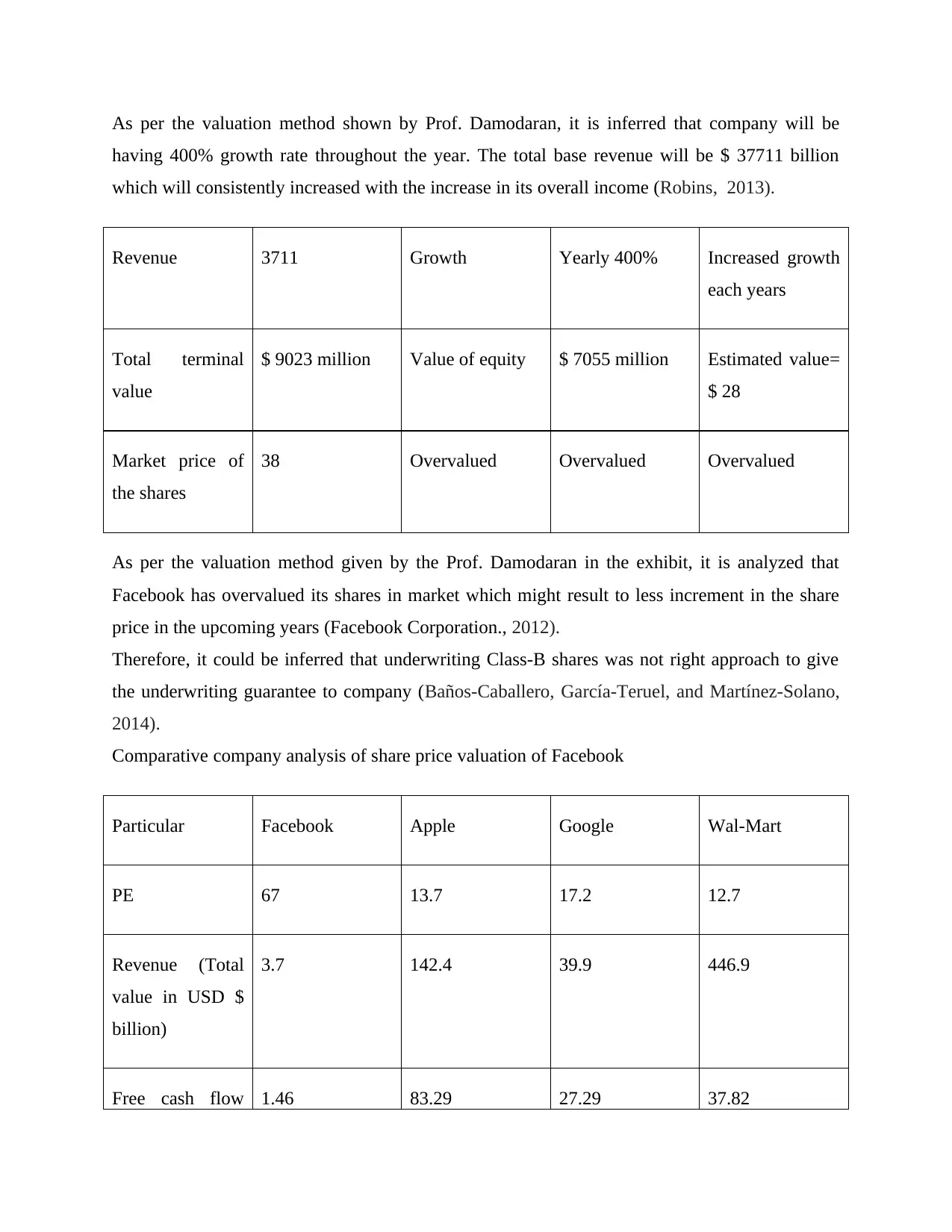
As per the valuation method shown by Prof. Damodaran, it is inferred that company will be
having 400% growth rate throughout the year. The total base revenue will be $ 37711 billion
which will consistently increased with the increase in its overall income (Robins, 2013).
Revenue 3711 Growth Yearly 400% Increased growth
each years
Total terminal
value
$ 9023 million Value of equity $ 7055 million Estimated value=
$ 28
Market price of
the shares
38 Overvalued Overvalued Overvalued
As per the valuation method given by the Prof. Damodaran in the exhibit, it is analyzed that
Facebook has overvalued its shares in market which might result to less increment in the share
price in the upcoming years (Facebook Corporation., 2012).
Therefore, it could be inferred that underwriting Class-B shares was not right approach to give
the underwriting guarantee to company (Baños-Caballero, García-Teruel, and Martínez-Solano,
2014).
Comparative company analysis of share price valuation of Facebook
Particular Facebook Apple Google Wal-Mart
PE 67 13.7 17.2 12.7
Revenue (Total
value in USD $
billion)
3.7 142.4 39.9 446.9
Free cash flow 1.46 83.29 27.29 37.82
having 400% growth rate throughout the year. The total base revenue will be $ 37711 billion
which will consistently increased with the increase in its overall income (Robins, 2013).
Revenue 3711 Growth Yearly 400% Increased growth
each years
Total terminal
value
$ 9023 million Value of equity $ 7055 million Estimated value=
$ 28
Market price of
the shares
38 Overvalued Overvalued Overvalued
As per the valuation method given by the Prof. Damodaran in the exhibit, it is analyzed that
Facebook has overvalued its shares in market which might result to less increment in the share
price in the upcoming years (Facebook Corporation., 2012).
Therefore, it could be inferred that underwriting Class-B shares was not right approach to give
the underwriting guarantee to company (Baños-Caballero, García-Teruel, and Martínez-Solano,
2014).
Comparative company analysis of share price valuation of Facebook
Particular Facebook Apple Google Wal-Mart
PE 67 13.7 17.2 12.7
Revenue (Total
value in USD $
billion)
3.7 142.4 39.9 446.9
Free cash flow 1.46 83.29 27.29 37.82
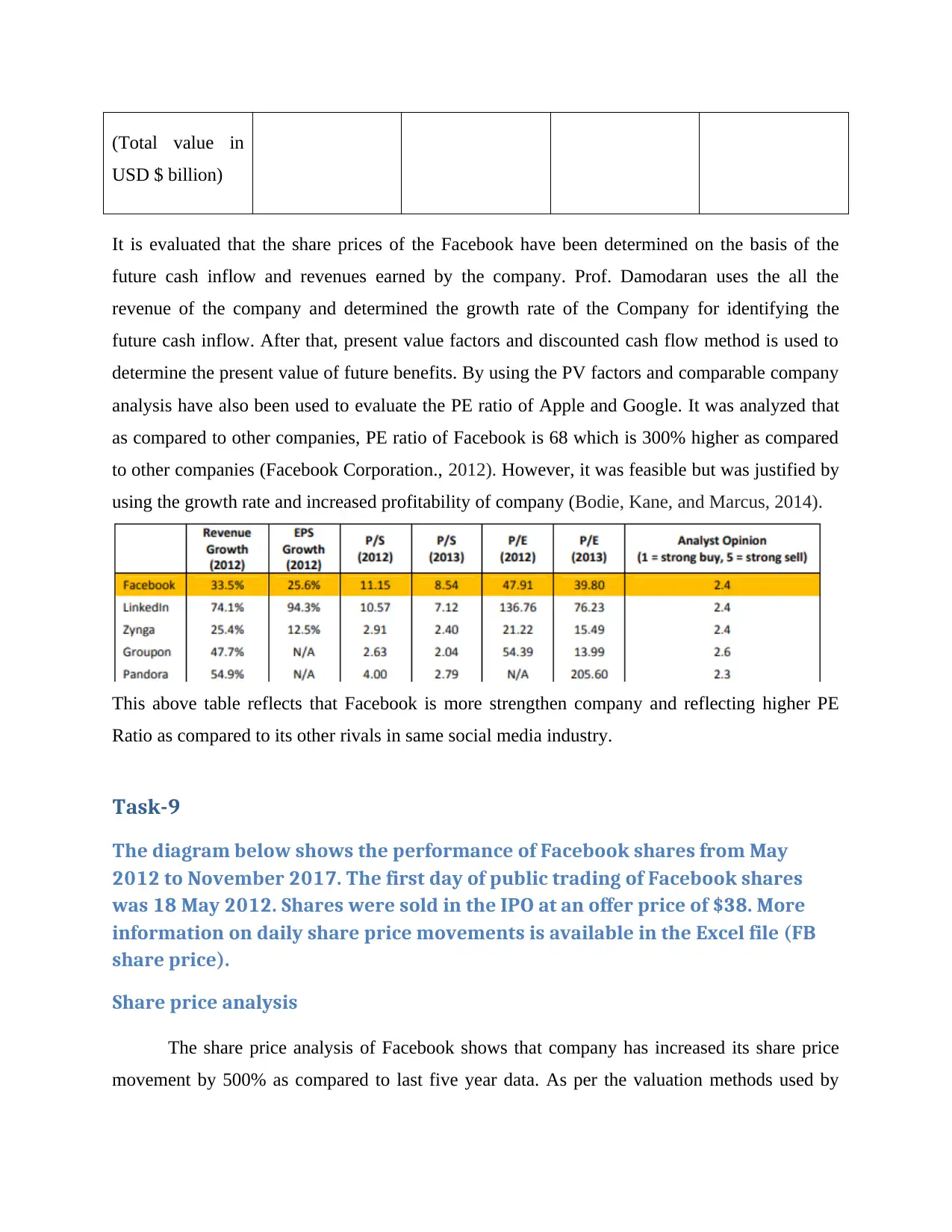
(Total value in
USD $ billion)
It is evaluated that the share prices of the Facebook have been determined on the basis of the
future cash inflow and revenues earned by the company. Prof. Damodaran uses the all the
revenue of the company and determined the growth rate of the Company for identifying the
future cash inflow. After that, present value factors and discounted cash flow method is used to
determine the present value of future benefits. By using the PV factors and comparable company
analysis have also been used to evaluate the PE ratio of Apple and Google. It was analyzed that
as compared to other companies, PE ratio of Facebook is 68 which is 300% higher as compared
to other companies (Facebook Corporation., 2012). However, it was feasible but was justified by
using the growth rate and increased profitability of company (Bodie, Kane, and Marcus, 2014).
This above table reflects that Facebook is more strengthen company and reflecting higher PE
Ratio as compared to its other rivals in same social media industry.
Task-9
The diagram below shows the performance of Facebook shares from May
2012 to November 2017. The first day of public trading of Facebook shares
was 18 May 2012. Shares were sold in the IPO at an offer price of $38. More
information on daily share price movements is available in the Excel file (FB
share price).
Share price analysis
The share price analysis of Facebook shows that company has increased its share price
movement by 500% as compared to last five year data. As per the valuation methods used by
USD $ billion)
It is evaluated that the share prices of the Facebook have been determined on the basis of the
future cash inflow and revenues earned by the company. Prof. Damodaran uses the all the
revenue of the company and determined the growth rate of the Company for identifying the
future cash inflow. After that, present value factors and discounted cash flow method is used to
determine the present value of future benefits. By using the PV factors and comparable company
analysis have also been used to evaluate the PE ratio of Apple and Google. It was analyzed that
as compared to other companies, PE ratio of Facebook is 68 which is 300% higher as compared
to other companies (Facebook Corporation., 2012). However, it was feasible but was justified by
using the growth rate and increased profitability of company (Bodie, Kane, and Marcus, 2014).
This above table reflects that Facebook is more strengthen company and reflecting higher PE
Ratio as compared to its other rivals in same social media industry.
Task-9
The diagram below shows the performance of Facebook shares from May
2012 to November 2017. The first day of public trading of Facebook shares
was 18 May 2012. Shares were sold in the IPO at an offer price of $38. More
information on daily share price movements is available in the Excel file (FB
share price).
Share price analysis
The share price analysis of Facebook shows that company has increased its share price
movement by 500% as compared to last five year data. As per the valuation methods used by
⊘ This is a preview!⊘
Do you want full access?
Subscribe today to unlock all pages.

Trusted by 1+ million students worldwide
1 out of 21
Related Documents
Your All-in-One AI-Powered Toolkit for Academic Success.
+13062052269
info@desklib.com
Available 24*7 on WhatsApp / Email
![[object Object]](/_next/static/media/star-bottom.7253800d.svg)
Unlock your academic potential
Copyright © 2020–2025 A2Z Services. All Rights Reserved. Developed and managed by ZUCOL.





